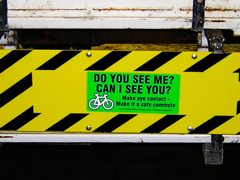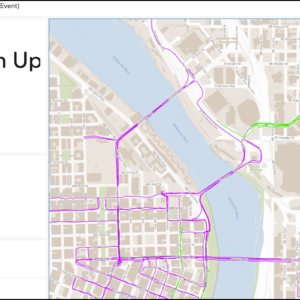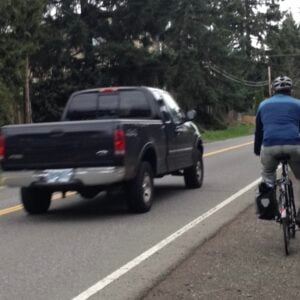
back and side of all trucks in the City
of Portland’s Maintenance Operations fleet.
(Photo: PDOT)
The City of Portland is making good on a promise to lead the way in an effort to improve bike and truck safety. Today, they announced an event that will give people an opportunity to see what life on Portland’s roads is like for truck drivers.
The Share the Road Bike-Truck Safety Education Event is scheduled for next Tuesday on SE Clinton street, one of the city’s busiest bikeways. According to the official press release, the event will give everyone a chance to view the roadway from the driver’s perspective by climbing into the cab of a large working vehicle.
“While we may think that a driver may see a cyclist, add in the possibility of greater noise from the larger engines, lower gearing, and heavier suspension. Professional drivers may also be listening to work-related calls coming over a two-way radio. Oftentimes, driving up a curb or even running over a metal item, like a bicycle, can feel like a small pothole or nothing at all to a large vehicle.”
The event announcement also confirms that the City of Portland’s Maintenance Operations unit will install bike guards on its trucks and will place bright green stickers on the rear and right side where “bicyclists are more likely to notice them”.
The stickers read, “Do you see me? Can I see you? Make eye contact — Make it a safe commute”.

No word yet on whether or not any truck drivers at the event plan to straddle a bicycle to educate themselves about what it’s like to operate a 30-pound, two-wheeled vehicle mere inches from a multi-ton machine.
- Bike – Truck Safety Education Event
Tuesday, April 29
4:30 – 6:00 p.m.
SE Clinton St. just west of SE 39th






Thanks for reading.
BikePortland has served this community with independent community journalism since 2005. We rely on subscriptions from readers like you to survive. Your financial support is vital in keeping this valuable resource alive and well.
Please subscribe today to strengthen and expand our work.
Every one of them should have to ride a bike in traffic to get a commercial license.
And, by the way, when are we going to start organizing rides for PPB officers and traffic court judges?
This is slightly tangential to city trucks.
While for the most part I\’ve found city drivers to be very cool and attentive, I had a really sketchy encounter with a city van driver the other day. It really wasn\’t a \”error\” type of thing. It was a driver behaving in an overtly dangerous manner.
I got the license plate and called the city and got quite the \”pass the buck\” treatment, with one guy actually trying hard to get me to the right person. But I\’ve still not heard back from anyone.
I\’d like to see a plainly visible number on city vehicles about who to call when there is an issue.
DJ (#1),
Can\’t disagree with the notion that truckers (and probably all drivers) should spend some time on a bike, in traffic, before being granted a license to drive. By the same token, cyclists could gain some valuable perspective on what the world looks like from behind the wheel of a large commercial vehicle. Maybe then they would rely more on heightened awareness and critical thinking skills to keep themselves safe, and less on laws that rarely provide more than punitive measures against those who violate them.
DJ..then you should have to take a CDL to ride your bicycle so you know about blind spots and truck handling in urban areas…
just sayin\’….we\’re all traffic, remember.
how about like rear cams for these trucks?
like on the back of the truck.
stickers are a step forward.
Joe
I think the stickers are a great idea – low cost, and they help spread the idea to drivers following as well. (OK, I\’m being idealistic :). Nice to see some quick action from PDOT. You might argue it\’s not enough but surely it\’s better than just lip service.
DJ..then you should have to take a CDL to ride your bicycle so you know about blind spots and truck handling in urban areas…
No, there is no licensing requirement to ride a bicycle. And that\’s for a very good reason: The truck driver can kill the cyclist with one single moment of inattention, but the opposite is not true.
The state\’s job is not to impose regulatory requirements on people because they impose them on some others, but to impose requirements that mitigate roadway risks – there is only one such risk here.
I do agree in general that it\’s a good idea for cyclists to drive large vehicles to see what it\’s like. Experience can only help. But the fact is that virtually all cyclists have driven motor vehicles, whereas virtually no commercial truck drivers – the ones whose vehicles create the risk to cyclists – have ridden a bicycle on roads shared with those vehicles.
\”And, by the way, when are we going to start organizing rides for PPB officers and traffic court judges?\”
When we start requiring family court judges them to beat their spouses before ruling on domestic violence charges.
Laws and licenses also exist to protect stupid people from themselves, and the state from having to foot the bill for their recklessness.
Did you take over the role of official bantering snob from Che Heaps?
DJ..virtually all cyclists have ridden motorocycles? huh? what are you talking about? I would have to really disagree and think you\’re speaking more from your own personal experience than factual evidence.
cyclist could benefit from knowing what a truck driver can and cannot see behind the wheel of the vehicle their chosen job gives me each day..each truck is different and cyclists should learn to not assume drivers can see them in a vibrating side view mirror or otherwise.
I\’m well aware of licensing requirements..I\’m hardly referring to them however. I\’m simply arguing the converse to your first statement…
fact is a lot of cyclists in this town are morons…assuming traffic will simply leap out of their way as they break any/all traffic laws…i see it daily.
Although bicyclists can\’t kill people in a car, they can very well kill themselves.
Bicyclists, like those in Amsterdam, Germany, and Copenhagen, should be required to take license and training tests.
Lately I\’ve been seeing at least 3 or 4 bikes per day riding the wrong way down 1-way streets. This on top of the red light runners…
note that I bicycle and do not own a car. But there are so many stupid bicyclists that I think most car drivers think we all have death wishes.
Please obey the rules of the road!
DJ..virtually all cyclists have ridden motorocycles?
Did I say this?
@ #9: If you can\’t see the difference between a crime and riding a bicycle, I guess you\’re even dumber than you sound.
Bicyclists, like those in Amsterdam, Germany, and Copenhagen, should be required to take license and training tests.
Three words: Never Gonna Happen!
DJ and bahueh,
DJ said \’virtually all cyclists have driven motor vehicles\” – not \’motorcycles\’.
Cyclists, and readers, could do well to slow down just a tad, and pay attention a lot more. They might live longer and make less a fool of themselves (I include myself in this reminder).
I think this is a great event! I somewhat agree with DJ Hurricane that the CDL should require truck drivers to ride a bike in traffic, or at least feel what it\’s like to be on a bike when a truck passes 3\’ away. Ditto for automobile licenses. They should also require drivers to cross a couple of busy streets as pedestrians – MLK or Grand between Burnside and Hawthorne would work perfectly. Have them do a crossing at a marked crosswalk and at an unmarked one.
I\’d also love for cyclists to have to walk 5 laps around Ladd\’s Circle, to see what it feels like to be a pedestrian when cyclists pass within a couple feet without stopping.
All modes need to have respect for the less-protected modes. Our driver education system does not take this into account, and as a result, we have a lot of clueless drivers out there.
tonyt,
Every city vehicle has on it what bureau it is from (with the rare exception of the generic \”City Fleet\”) — it\’s on the door under the \”City That Works\”. So you could try getting in touch with that bureau\’s safety person by calling that bureau directly. I know that the Water Bureau, for example, takes such things very seriously… I think one of their safety folks even reads BikePortland. Also if you know the 6 digit vehicle number that could help — it\’s on the side of the vehicle and usually on the front and rear someplace, too, in black letters.
1. Is it fair to ask that drivers pull over If the two way call is a distraction that might result in an accident?
2. Is there a way to get a better set of mirrors that would provide better visibility for the driver?
Raymond Dawthorne, a veteran equipment operator for the Bureau of Maintenance presented this campaign at the PDOT Bicycle Brown Bag session on March 20th. Both of his daughters are bicycle commuters and heavy equipment operators like their dad. His motives for increasing safety for cyclist are honest and true. Check out http://bikeportland.org/2008/03/21/bureau-of-maintenance-outlines-bike-safety-measures/. Mechanisms such as improved vehicle mirrors, proximity sensors and audible warning devices that sound when the right turn signal is on are other equipment solutions to improve bicycle safety that are being discussed. Portland City heavy equipment operators are sensitive to vulnerable members of traffic. The hope is for private operators to follow their lead.
I have to say I\’m not real impressed with PDOT\’s efforts on this. While some effort is better than no effort, ambiguous signs and over-engineered palliatives probably won\’t have much of an effect on the underlying problems. PDOT is treating the symptoms, not the disease. Trucks cannot turn from a curb-tight position, they have to swing wide to avoid driving their rear wheels up onto the curb. I have no doubt that when they swing out (or stay to the left of a bike lane stripe that is striped all the way up to the intersection in compliance with the defective Oregon MUTCD for bicycle lanes), it\’s creates a very ambiguous situation; is the truck driver \”yielding\” (can he even see the cyclist trying to overtake on his right?). Cyclists should be heavily discouraged from overtaking on the right of right-turning trucks (and cars for that matter); it\’s dangerous enough with small cars, but long trucks swing across the bike lane in a way that prevents all hope of escape for the cyclist (which so tragically took the life of Brett Jarolimek). The smarter traffic engineers in California have been putting up signs like this:
http://rmshant.googlepages.com/Stanfordrighthookphoto2a.jpg
Until PDOT addresses the source of the problem, I will have no confidence in their \”safety\” efforts. After the October tragedies I\’ve seen these \”safety\” efforts progress from excuses and subterfuge to defective and unapproved traffic control devices (the bike boxes). This is an engineering blunder that needs to be fixed immediately. All other efforts should be secondary. Wheel well guards and signs simply promote safe crashing.
Since so many cyclists (and PDOT employees) are enamored with Dutch bicycle facilities, I found it kind of interesting when I received an e-mail with this link:
http://www.nieuwsui tamsterdam. nl/English/ 2008/04/blind_ spot.htm
4 right-hook fatalities in 2006 in Amsterdam of all places. I\’m grateful that PDOT at least doesn\’t put up the physical barrier in the photo that forces the right-hook collision (terrifying!). I also heard through the grape vine that some European countries are moving away from segregated facilities. Apparently Switzerland announced at the 2007 Velo City conference that they are abandoning sidepaths and bike lanes and only striping bike lanes where they don\’t create traffic conflicts. I need to find a link, I\’ll post it if I come across one. The Dutch have also been utilizing concepts from shared space:
http://en.wikipedia.org/wiki/Shared_space
Hans Monderman was a brilliant Dutch traffic engineer that pioneered all kinds of concepts that increased the interaction between roadway users (such as traffic circles instead of traffic signals, which require drivers to actively negotiate maneuvers rather than blindly obey traffic lights).
BTW, many of the facilities and designs (like colored bike lanes) that our DOT is so enamored by were popular in Europe in the 70s. I think Europe is starting to move away from many of these now that they are realizing the dangers. The Dutch are also catching up to the U.S. with car-bike collision studies (which we first did in the mid 70s, a la Kenneth Cross). If there\’s anything that our DOT should be copying from the Dutch, it\’s the Shared Space concepts, it looks promising.
I messed up that second link, here it is again:
http://www.nieuwsuitamsterdam.nl/English/2008/04/blind_spot.htm
We live in an imperfect world. Change for better or worse does not happen instantly. It is a process.
I agree, vulnerable user of the road will never be safe if motorist do not change their attitudes. This can only happen with major changes in driver’s education, licensing, current laws, law enforcement and subsequent punishment. Mandatory improvement in the engineering design of large moving vehicles will increase the safe maneuvering of trucks on our roadways. Grass roots attempts at creating such changes are in the works but there are major societal barriers to rapid improvement. In turn, cyclists and pedestrians also need to behave in a more predictable fashion.
Meanwhile, attempts at traffic management, be they bike lanes, bike boulevards, bike boxes, are attempts to create passageways that improve cyclist comfort, increase ridership and thus increase motorist awareness of cyclists. In fact the creation of bike boulevards as planned in the Safe, sound and green streets proposal are actually low speed shared space.
Yes, PDOT’s actions to date are just band-aids, but they are a start. Just like the California sign. Unless they’re on every intersection in California (which they are not) and unless California law has a statute to back up the sign with some significant punishment(I am not familiar with California cycling law)…it’s just another kind of band-aid.
Until we can achieve nirvana, we have got to start somewhere.
Just today I saw a biker ride the wrong way up a one-way weaving thru cars and 3 run red lights. I saw 2 yesterday blow the red light at 7th/Hawthorne where a bike box exists. Monday I saw a girl blow thru a ped cross walk at 37th & Hawthorne and hit a lady pushing a baby stroller!!!
I bike ALOT and we will get no respect until people get their head out of the clouds. No respect.
DRIVERS OF CARS FOLLOW THE RULES OF THE ROAD WAY, WAY MORE THAN BIKERS. PERIOD.
Sorry I am harping, but I NEVER see cars pulling the stunts bikers do… I try to talk about it with normal everyday office workers and the laugh me off like an old weird cousin. Because they see it on the roads everyday. What can I say to them? \”Oh, not me doing it.\”
I think this is a great idea. Having driven large commercial trucks, I can attest to how difficult it can be to see bikes at times. Sometimes it\’s like, \”I saw a bike, where did he go? Is he in my blind spot, or did he turn off?\” My bottom line is, as a cyclist I am responsbile for my own safety. If I crash, it\’s somehow my fault. I failed to anticipate a potential hazard and leave myself enough time/space to react. Riding with cars and trucks is and will continue to be the reality. Knowing the drivers\’ perspective is a great idea. I think cycling makes me a better driver, and driving makes me a better cyclist.
What Lazlo said.
🙂
@yarrum69, \”DRIVERS OF CARS FOLLOW THE RULES OF THE ROAD WAY, WAY MORE THAN BIKERS. PERIOD.\”
Bullsh*t.
Take a look around you, drive on I5, drive on any city street, look at the crash debris at EVERY intersection, wathc motorists on cell phones weave in traffic, and watch cars \”slow and go\” at nearly every stop sign. I\’ll grant you the relatively small number of cyclists that break the law, and raise you the huge absolute number of motorists doing things that will KILL US INSTANTLY due to inattentiveness, carelessness, speed, and aggression.
The policy and action of PDOT on this matter is great and should be applauded. This sets an example for the motoring public to emulate.
Right on Lazlo. Even with additional mirrors large trucks will still have blind spots. And, the driving public as well as bicyclists should be reminded of this and avoid them.
Yes there are some new technologies but they are expensive for now and there are problems with those as well. (do you want the truck driver next to you watching a video view screen or watching the road and where he is going? what if the bicyclist is deaf? and the like)
I\’ve had cars squeeze into the space between me and the curb when I am in the act of making a right hand turn at an intersection because I had moved left slightly in order to make the right turn in a large farm truck. And I had used my signal.
While this wasn\’t in Portland, I witness cars doing the same thing all the time in Portland. (you can see this at 11th and Division)
Most truck companies have a picture of a car about to get hit by a wide turning truck. Passing a large truck on the right is not a smart thing to do in a car, SUV or on a bike and we need to do a better job at getting the word out. Even with that people will continue to be in too much of a hurry to wait for the truck to turn and try to sneak around.
Trucks on the road is a reality for now and the near future, at least until we run out of gas. And, bicycling is here to stay and will continue to grow in numbers.
In regards to the California sign that shows the truck about to hit the bike in a bike lane. Love it. It does send a pretty \’biking is scary\’ message to the \’interested but concerned\’ potential riders we need to reach. I think the colored treatments and accompanying signs here in Portland are a more positive bike-friendly approach to alerting road users of the potential conflicts.
Most of the research also shows that more traffic control signs blend in with other visual clutter and tend to be unobserved or ignored by a majority of road users.
I would like to see a graphic of that sticker on the passenger door at cyclists eye level on every truck that operates in Porltand. It\’s immediate and conveys the impending danger that the cyclists is in \’right now\’! At that point it\’s too late for education and a harsh direct warning is in order.
There are many folks from the truck driver and freight community who really want to develop a training curriculum for truck drivers focusing on safety around bikes. The BTA has a bike safety training they do for drivers and can work with these folks and the City to develop a training for truck drivers. The different players are all starting to come together.